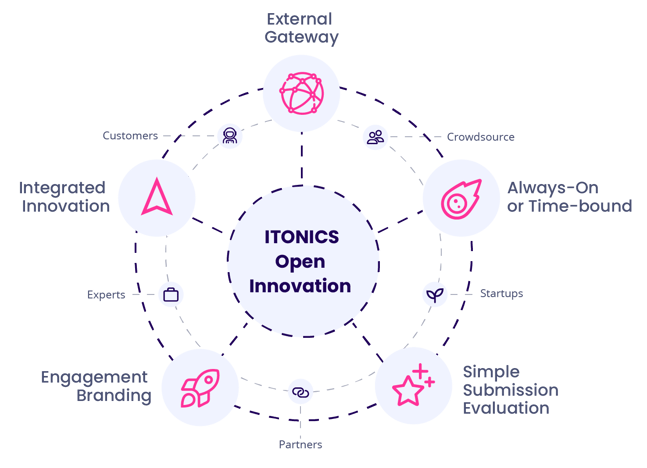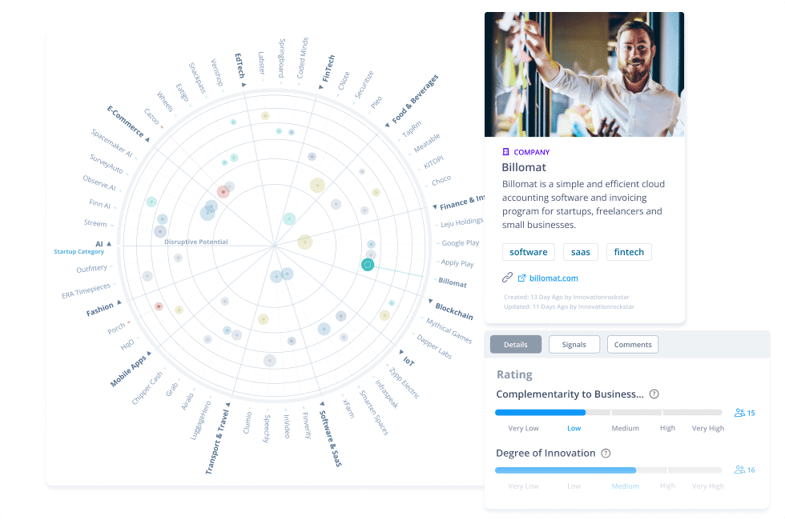Companies can increase their competitiveness by reaching beyond their own four walls and becoming more collaborative. Forging relationships with technology partners through open innovation techniques is an effective way to access external competencies and integrate new technologies.
But how does it work in practice? In this article, we'll explore the various types of technology partnerships, delving into what makes each unique and how they can best serve your innovation goals. We'll guide you through two primary open innovation models for attracting tech partnerships and how to select the right tech partner that will effectively complement and enhance your company's innovation trajectory—ensuring a collaborative, productive, and mutually beneficial relationship.
What are the different types of tech partnerships?
Technology partnerships come in various forms, each with unique characteristics and benefits. Understanding the different types of tech partnerships is crucial for any company looking to leverage external expertise and technology for growth and innovation.
|
Type of tech partnership |
Best for… |
Partner profile |
Tips for success |
|
Strategic partnerships: Long-term, multi-faceted collaborations |
Combining strengths, sharing risks, and achieving goals that would be challenging individually. |
Companies with complementary strengths and shared strategic goals. |
Align strategic goals, foster mutual trust, and regularly reassess the alliance. |
|
Vendor ventures: collaborations for specific technology solutions |
Accessing cutting-edge technology and specialized expertise without internal development. |
Tech vendors and suppliers with specific products or services that meet your business needs. |
Specify clear deliverables, establish an issue-resolution protocol, and conduct ongoing performance evaluations. |
|
R&D partnerships: partnerships for innovation and development |
Navigating industries where cutting-edge innovation is key, like biotech or aerospace sectors. |
Universities, research institutions, or other companies with complementary R&D capabilities. |
Leverage complementary strengths, clarify IP rights upfront, and maintain open knowledge sharing. |
|
Licensing agreements: allowing the use of your technology or brand |
Expanding market reach and monetizing intellectual property without direct selling. |
Companies seeking to expand their offerings without developing new technologies in-house. |
Detail usage rules, monitor for compliance, and adapt to market shifts. |
|
Joint ventures: forming a new entity or project collaboration |
Entering new markets or pooling resources for large projects. |
Companies with shared interests in a particular project or market but that wish to retain their separate identities. |
Balance governance, define operational roles, and ensure transparent communication. |
|
Outsourcing partnerships: hiring another company for specific tasks |
Reducing costs and focusing on core competencies. |
Companies specializing in the defined outsourced function, domestically or internationally. |
Craft clear service agreements, review performance consistently, and collaborate on solutions. |
|
Innovation ecosystems: networks for collaborative innovation |
Promoting dynamic and synergistic innovation through shared ideas and resources. |
Startups, academia, research institutions, and other companies. |
Create a diverse partner network, encourage open innovation, and align goals and incentives. |
Honorable mention: Venture clienting
Venture clienting, used by innovation leaders like DB Schenker and Bosch, is a relatively new model for pragmatic tech partnerships. It involves a large company acting as the client to a startup, providing it with early-stage revenue, feedback, expertise, and access to markets. In return, the startup provides innovative solutions and technology that can be integrated into the large company's business operations.
Venture clienting offers a more agile, low-risk approach to accessing external innovation compared to joint ventures and corporate venturing. It enables companies to quickly test and deploy innovative solutions while minimizing the complexity and commitment associated with other collaboration models.
With the right tech partnership strategy in place, the benefits are many. From growing your business and reaching new customers to differentiating your offering while reducing costs. Tech partnerships allow you to tap into specialized expertise and resources that may not be available internally. They are a vehicle for making innovation accessible, scalable, and fast.
How to attract tech partnerships
Attracting external technology partnerships—as opposed to actively scouting for them—requires an open innovation approach. By opening the doors to collaboration and inviting external tech experts to contribute their knowledge and ideas, you can tap into a wealth of innovation that may not be readily available within your own walls.
There are two primary models for attracting tech partnerships through open innovation:
| Broad outside-in Problem hunting |
Defined outside-in Solution hunting |
|
This model involves casting a wide net to gather diverse and innovative ideas from external tech partners without predefined constraints. It is particularly effective for identifying new problems or opportunities that the company hadn't previously considered. |
This model focuses on soliciting specific, targeted solutions or ideas from external tech partners. Companies adopting this approach have clear objectives and defined challenges they wish to address, seeking innovative solutions that align with these pre-set criteria. |
|
Example: IBM's Call for Code initiative invites global developers, scientists, and problem solvers to address societal challenges like natural disasters and healthcare crises. Through this initiative, IBM harnesses the collective expertise of external tech partners to identify and tackle problems that may not have been previously considered within the company's innovation portfolio. |
Example: KPMG's Global GenAI Innovation Challenge, co-sponsored by ITONICS, was a call for novel applications of GenAI in innovation management. It attracted diverse ideas from employees, clients, and partners, producing several actionable solutions. This challenge exemplified how targeted open innovation can effectively utilize external insights to solve specific challenges. |
Whichever model you follow, leveraging an open innovation platform streamlines tech partnerships from the first touchpoint through to technology development and launch.

The ITONICS Innovation OS provides a centralized hub for inviting, evaluating, and collaborating with external tech partners. So whether you're casting a wide net or seeking targeted tech solutions, ITONICS offers the flexibility and scalability to support your open innovation initiatives.
How to select the right tech partners
If you’ve set up your tech partnership campaign effectively, communicated it to the right audience, and made submission fast and easy with the support of an open innovation platform, then you may face a new challenge: a flood of potential partners to sift through, evaluate, and ultimately select to move forward with. While not a bad challenge to face, it nonetheless requires a systematic solution.
Our Innovation Rockstar guest, Kelly Van Dyke, Director of R&D External Innovation at PepsiCo, emphasizes the importance of understanding the specific needs and context of the problem you're trying to solve and matching it with the capabilities and scalability of potential tech partners. For her, it’s all about aligning the right company, technology, and stage of development.
When starting a collaboration with a start-up, you should ask yourself the following three questions: Is it the right company? With the right technology? At the right time?
— Kelly Van Dyke, Director of R&D External Innovation at PepsiCo
Here is a breakdown of these critical questions to ask when assessing the viability and potential value of technology partnerships:
Who: Is it the right organization?
Assess the partner's vision, mission, and values to ensure alignment with your organization's goals and culture.Consider the startup's financial stability, scalability, and potential for long-term success.
Evaluate the startup's leadership team, their experience, and their track record in the industry.
What: Is it the right technology?
Assess the partner’s intellectual property portfolio, patents, and proprietary technology.Consider the scalability, flexibility, and interoperability of the technology to meet your current and future needs.
Evaluate the partner's technology stack, including its relevance to your industry, uniqueness, and competitive advantage.
When: Is it the right time?
Assess the readiness of your organization, including internal resources, capabilities, and strategic priorities.
Consider market dynamics, trends, and timing to determine if it's the opportune moment to collaborate with the startup.
Evaluate external factors such as the regulatory environment, competitive landscape, and market demand to gauge the timing of the collaboration.
With so much to evaluate, having a centralized innovation operating system becomes invaluable. It streamlines the collection and connection of crucial information, facilitates expert evaluation, and contextualizes data within your innovation ecosystem. This empowers you to make strategic, well-informed decisions about your tech partnerships, ensuring they align with your innovation objectives and drive your organization's success.

Perfect match: streamlining tech partnerships with ITONICS
Unlock the power of streamlined tech partnerships with the ITONICS Innovation OS, where collaboration meets AI-driven efficiency. Remove the effort and complexity of selecting and managing partnerships and get down to the business of innovation faster.
- Enhance open innovation with collaborators and tech partners through accessible external gateways, customizable templates, and automated campaign workflows.
- Visually map out your technology portfolio and spot gaps, roadblocks, and synergies within your partnership network using planning tools like Roadmap and Kanban Boards.
- Track the status and health of your partnership campaigns with dynamic dashboards that offer real-time insights and key metrics for quick reporting and decision-making.
- Standardize the evaluation of tech partnerships with collaborative ratings. Quickly identify opportunities you want to capitalize on with Radar and Matrix visualizations.
- Validate tech partnerships by automatically categorizing, tagging, and connecting them with your foresight intelligence, internal subject-matter experts, and existing ideas and projects.
Don’t just find your perfect tech match; unlock its full potential with the ITONICS Innovation OS!
FAQs
-
What metrics or indicators can organizations use to gauge the success of their technology partnerships over time?
Organizations can measure the success of technology partnerships by evaluating metrics such as innovation rate, market share growth, and return on investment, which reflect the tangible outcomes of the collaboration.
-
How should companies handle conflicts or disagreements that arise within technology partnerships, ensuring they do not derail the collaboration?
When conflicts arise in technology partnerships, effective resolution strategies include clear communication, third-party mediation, and predefined conflict resolution mechanisms in the partnership agreement, ensuring that disputes are managed constructively.
-
How can companies ensure that their technology partnerships evolve alongside changes in technology and market dynamics to remain relevant and beneficial?
To ensure technology partnerships evolve with changing market and technology landscapes, companies should incorporate regular reviews, adaptability clauses, and strategic alignment checks into their partnership agreements, fostering a dynamic and responsive collaboration framework.










